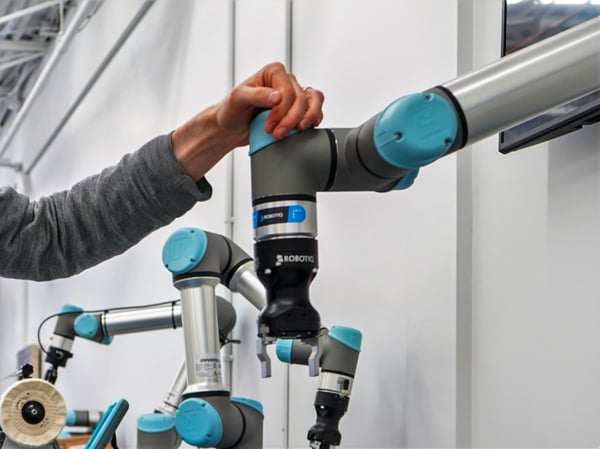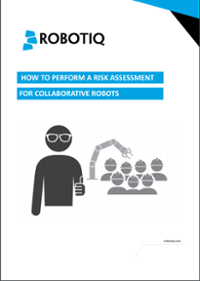How Safety Levels Are Decided for Cobots

Posted on Feb 28, 2019 in Collaborative Robots
5 min read time
Are cobots too safe? Are cobots safe enough? Our experts can't seem to agree. Here's how safety levels are decided for collaborative robots.

There was a little disagreement between the experts at our 2018 Robotiq User Conference (RUC). Esben Østergaard of Universal Robots thought that the current safety limits were "super-conservative, bordering on the ridiculous." On the other hand, Jeff Burnstein from A3 was keen to draw attention to the point that cobots are not inherently safe and told a story of when a (supposedly safe) cobot almost broke his hand.
Are cobots too safe or are they not safe enough?
It's a difficult question with no clear answer. But, we can shed some light on the issue by looking at how cobot safety levels are defined.
Where are cobot safety levels defined?
Probably the most widely recognized source of safety levels for cobots is the ISO/TS 15066. This is a technical report produced by the International Organization for Standardization (ISO).
ISO defines standards for almost everything, from the size of general purpose screws (ISO 68) to the microbiology of animal foodstuffs (ISO 21567:2004). My favorite standard (and probably other people's as well) is ISO 3103, which defines the standard process for making a cup of tea.
ISO/TS 15066 (Robots and robotic devices -- Collaborative robots) is not actually a standard yet. It is a technical specification (hence the TS). This means that more technical development is required before it is turned into a full standard.
For our purposes, this means that the safety limits which are defined within it are likely to change. As we better understand the practicalities of working alongside a collaborative robot, the limits will be updated. However, even though it's not a full standard yet, I'll still refer to it as a "standard."
You can find out all about the standard in our eBook ISO/TS 15066 Explained.
Who decides cobot safety levels?
The safety levels defined in the standard specify the maximum force that a cobot can apply when it collides with a human. As we discovered during the RUC, people have different opinions about what constitutes a safe limit. That's why there are a variety of people in the standard's technical committee.
All standards are produced by a technical committee (TC). The cobot standard is produced by ISO/TC 299 (Robotics). The current chairperson of this committee is Staffan Elfving from ABB robotics and the current secretary is Katarina Widström from the Swedish Standards Institute. The members participating in this committee come from 27 ISO member states, largely from North America, Europe, Australia, and South-East Asia.
Any stakeholder with a significant interest in a particular standard can get involved with its development. To do so, you have to get involved via the standards organization in your country which is a member of ISO (which can be found on this list).
How standards are defined
All standards go through a defined sequence of steps. ISO/TS 15066 is still undergoing this process.
These steps are:
- A new work item is proposed. In our case, the collaborative robot standard.
- Expert consensus is built by the technical committee. A "committee draft" is produced of the standard.
- The technical committee works towards a consensus. From this, an ISO/TS is produced. This is the stage where ISO/TS 15066 is currently.
- After all changes are made, an enquiry is made to the Draft International Standard. The final text is then submitted for processing.
- A formal vote of the completed standard is made. This vote is used to determine if the technical specification is turned into a full ISO standard.
- The new standard is published.
The development of a standard usually takes around 3 years. However, ISO/TS 15066 has been published as a technical specification and looks to stay that way for the moment. At some point in the future, it will be published as a full ISO standard, but not yet.
As a result, the safety limits are likely to change.
The big issue: Injury vs pain
One of the big questions around collaborative robot force limits is: What does safe mean?
There are two ways you can define safety:
- The robot does not injure a person when it collides with them.
- The robot does not hurt a person when it collides with them.
These two definitions may look similar, but the difference between them can be huge. Consider the difference between dropping a heavy book on your foot so that it hurts and dropping a book which is so heavy that it actually breaks your toe.
In the early drafts of ISO/TS 15066, the safety limits for cobots were defined as the "onset of injury." However, they were later changed to be the "onset of pain." This leads to power and force limits which are lower, which means the robot has to move much slower to stay within the limits. This "onset of pain" is what Esben Østergaard was objecting to at the RUC. Pain is subjective and pain thresholds are conservative.
Although it is possible that the current limits are overly conservative, there is a good reason for keeping them low. The ALARA principle (which stands for As Low As Reasonably Achievable) says that you should reduce the risk as much as you can. If it's possible to achieve lower pain limits with cobots then you should.
How to make sure your cobot is safe
Now that you know where the safety limits for cobots come from, you can probably see that it is quite a gray area. We don't yet know what the final safety limits will be for collaborative robots when the technical specification is turned into a full standard.
The solution is to focus on the specific risk of your application. Risk assessment is vital. This is something that all of our experts at RUC 2018 could agree on. Safety levels are very application specific.
When you perform a good risk assessment, you can be sure that your application will not injure or harm people.
Check out our eBook How to Perform a Risk Assessment for Collaborative Robots to find out how to perform good risk assessments.
What are your thoughts on the "onset of pain" or "onset of injury" debate? Tell us in the comments below or join the discussion on LinkedIn, Twitter, Facebook or the DoF professional robotics community.







Leave a comment